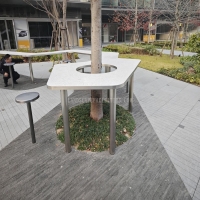Welcome to the website for landscape facilities products and knowledge.
How does the design of a landscape bar counter influence its ability to accommodate both hot and cold food service?
The integration of hot and cold food service within a single landscape bar counter represents a sophisticated dance of material science, thermal engineering, and ergonomic design. Unlike traditional linear counters, landscape bar counters - characterized by their expansive, multi-level surfaces - utilize strategic zoning to maintain precise temperature control across different service areas.
The foundation of this thermal management begins with material selection. Quartz and engineered stone surfaces excel in heat resistance for hot plating zones, while integrated chilled marble or stainless steel sections provide ideal cold-holding surfaces. Advanced composites with thermal insulating properties create natural barriers between temperature zones, preventing cross-contamination of thermal conditions.
Beneath the surface, intelligent infrastructure separates the counter's heating and cooling mechanisms. Dedicated electrical circuits power induction warmers or infrared heat lamps in hot food sections, completely isolated from refrigeration compressors serving cold wells or drawer coolers. This electrical segregation prevents system interference and ensures consistent performance during peak service hours.
The vertical dimension of landscape counters enables sophisticated temperature layering. Lower levels often incorporate refrigerated drawers for cold ingredients, while middle surfaces maintain ambient temperature for preparation, and upper levels host heating elements. This vertical separation creates natural convection currents that further reinforce temperature differentiation without artificial barriers.
Ventilation systems play a crucial role in maintaining thermal integrity. Strategic airflow designs create invisible curtains between hot and cold zones, preventing steam from hot dishes from affecting chilled displays. Some designs incorporate localized exhaust systems that immediately capture heat at source points.
The workflow efficiency of these designs shows in their service patterns. Staff can simultaneously plate hot dishes from one counter section while assembling cold salads in another, all within natural arm's reach. This parallel processing capability significantly enhances service speed during rush periods while maintaining optimal food temperatures.
Modern iterations incorporate smart temperature monitoring with digital sensors that alert staff to any zone drifting from preset parameters. This technology integration represents the evolution of landscape bars from passive serving surfaces to active temperature management systems.
The ultimate success of these designs manifests in the customer experience - receiving perfectly hot items alongside properly chilled elements, all presented on a unified counter that appears as a seamless landscape of culinary offerings. This harmonious coexistence of temperatures elevates both functional service and aesthetic presentation in contemporary food service environments.
Related search:

Recommendation
An outdoor bar counter with stainless steel and terrazzo materials in an irregular shape